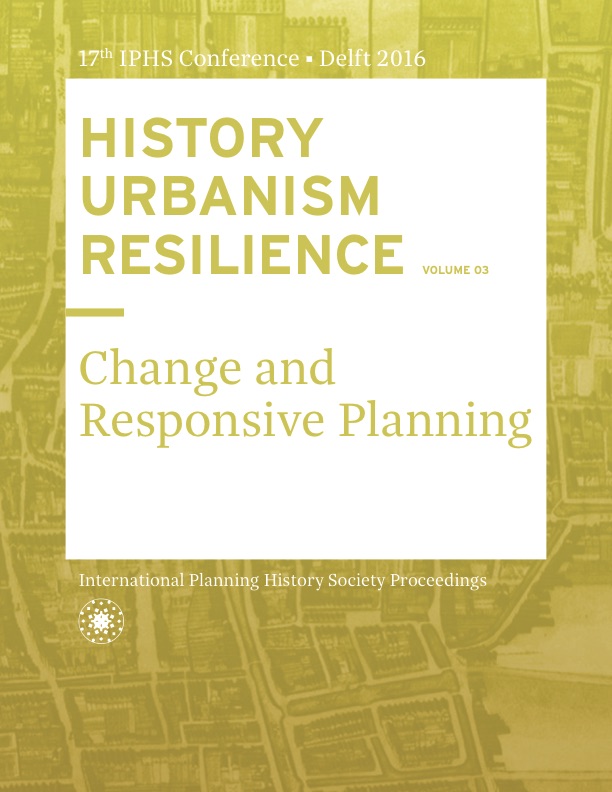Land in Limbo: Understanding Planning Agencies and Spatial Development at the Interface of the Port and City of Naples
DOI:
https://doi.org/10.7480/iphs.2016.3.1262Abstract
Numerous actors have been involved in the planning of the port and city of Naples; actors who have different ideas and goals, different tools, and even time-frames. The European Union, the Italian nation, the Campania Region, the Municipality of Naples, and the Port Authority act upon the port at different levels of planning. Each entity has different spatialities and temporalities. Their diverse goals have led port and city to develop into separate entities, from a spatial, functional as well as administrative point of view. The different scopes of their planning are particularly visible in the zone between port and city.
Using and challenging the theory of path dependency, this paper explores the diverging ways in which a range of different institutions have planned for port and city starting from nineteenth century until today. It studies how the introduction of different institutions and their evolution has influenced plan making over time. The case of Naples shows the challenges that arise from the palimpsest of plans and goals associated with port and city, and that are particularly visible in the port-city interface in Naples.
References
AIVP. “Partner of the World Urban Campaign.” AIVP, THE WORLDWIDE NETWORK OF PORT CITIES (2015).
———. “Plan the City with the Port: Guide of Good Practices.” AIVP, THE WORLDWIDE NETWORK OF PORT CITIES (2015).
Arrow, Kenneth J. “Path Dependence and Competitive Equilibrium.”
Bird, J.H. . The Major Seaports of the United Kingdom. London: Hutchinson, 1963.
Daamen, T.A. . “Sustainable Development of the European Port-City Interface.” In ENHR: European Network of Housing Research Conference 2007. Rotterdam, 2007.
Garud, R., Karnoe, P. Path Dependence and Creation. Mahwah: Lawrence Erlbaum Associates, 2001.
Gasparrini, Carlo. “Porto, Spazio Pubblico E Cita Metropolitana.” Portus, the online magazine of Rete, no. 28 (2014).
Girard, Luigi Fusco. “Toward a Smart Sustainable Development of Port Cites/Areas: The Role of the “Historic Urban
.” Sustainability (2013).
Gravagnuolo, B. . Napoli Il Porto E La Città. Storia E Progetti. Napoli: Edizioni Scientifiche Italiane, 1994.
Hayuth, Y. & Hilling, D. “Techological Change and Seport Development.” In European Port Cities in Transition. London: Belhaven Press, 1989.
Hein, C. “Port Cities and Urban Waterfronts: How Localized Planning Ignores Water as a Connector.” (2016).
———. “Port Cities and Urban Wealth: Between Global Networks and Local Transformations.” Int. J. of Global Environmental Issues vol. 13
(2014).
———. Port Cities: Dynamic Landscapes and Global Networks. New York: Routledge, 2011.
———. Port Cityscapes: Conference and Research Contributions on Port Cities. Planning Perspectives. 2016. doi:10.1080/02665433.2015.1119714.
———. “Temporalities of the Port, the Waterfront and the Port City.” PORTUS: the online magazine of RETE 29 (June 2015 2015).
Hoyle, B.S. and Pinder, D.A. . European Port Cities in Transition. London: Belhaven Press, 1989.
Mahoney, James. “Path Dependence in Historical Research.” Theory and society (2000): 507-48.
Merk, O., Dang, T. “The Efectveness of Port-City Policies; a Comparatve Approach.” OECD Regional Development Working Pape (2013).
Meyer, Han. City and Port. Rotterdam: International Books, 1999.
Pavia, R. . Le Paure Dell’urbanistica. Roma: Maltemi editore, 2005.
R. Amirante, F. Bruni, M. R. Santangelo. Il Porto. Napoli1993.
Rachel, R. M. . “Il Riassetto Del Fronte Sul Mare a Napoli, Approccio Socio-Economico.” In Napoli Il Porto E La Città. Storia E Progetti, Edizioni Scientifiche Italiane, edited by R. M. Rachel. Napoli, 1999.
Russo, M. Città Mosaico Il Progetto Contemporaneo Oltre La Settorialità. Napoli: Clean, 2011.
Russo, M., & Miano, P. . Città Tra Terra E Acqua Esplorazioni E Progetto Nel Dottorato Di Ricerca. Napoli: Clean, 2014.
Schreyogg, G., Sydow, J. The Hidden Dynamics of Path Dependence, Institutions and Organizations. London: Palgrave Macmillan, 2010.
Schubert, D. “Smart and Resilient Cities and Ports.Perspectives for Hamburg.” PORTUS: the online magazine of RETE, n.29, June 2015, Year XV, Venice, RETE Publisher 29 (2015).
Schubert, D. . “Seaport Cities, Phases of Spatial Restructuring and Types and Dimensions of Redevelopment’ “. In Port Cities: Dynamic Landscapes and Global Networks, edited by C. Hein. New York: Routledge, 2011.
Secchi, B. & Viganò, P. Antwerp, Territory of a New Modernity. Amsterdam: Sun Publishers, 2009.
Soja, E. W. . Dopo La Metropoli. Per Una Critica Della Geografia Urbana E Regionale. Bologna: Pàtron, 2007.
Sorensen, A. “Taking Path Dependence Seriously: An Historical Institutionalist Research Agenda in Planning History.” Planning Perspective (2015).
Vries, I. M. J. “From Shipyard to Brainyard - the Redevelopment of Rdm as an Example of a Con- Temporary Port-City Relationship.” In ALIX,Y. DELSALLE & B. COMTOIS, C. (eds) Port-City governance. Edi- tions EMS, 233-245.
(2014).

